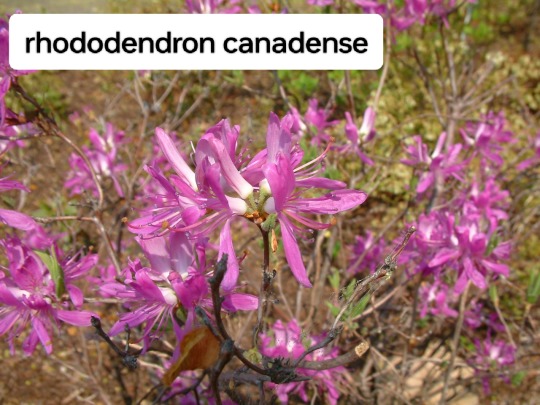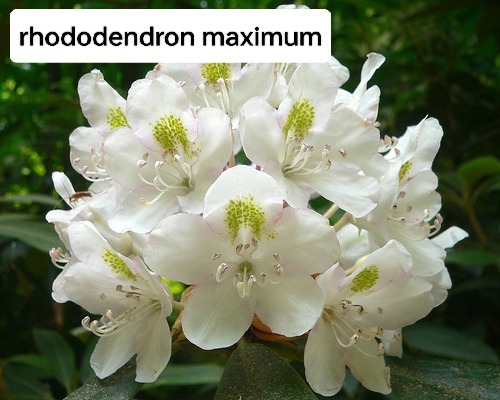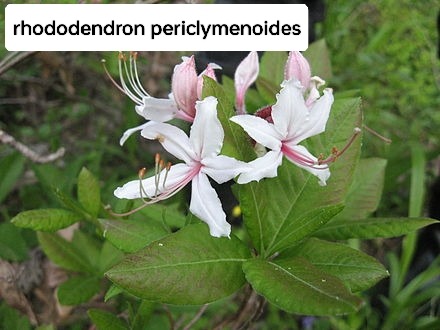#Rhododendron periclymenoides
Text
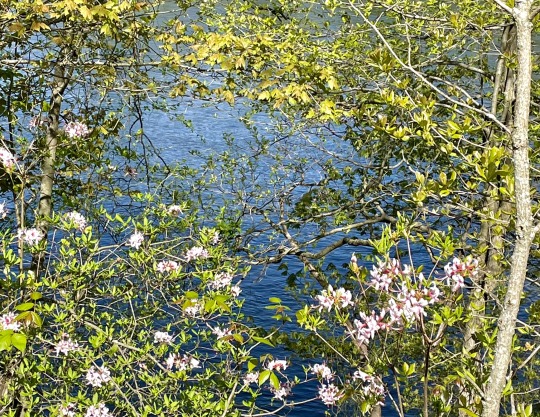
Wild azaleas along the Lehigh River.
359 notes
·
View notes
Text

Rhododendron periclymenoides / Pinxter Flower at the Sarah P. Duke Gardens at Duke University in Durham, NC
#Rhododendron periclymenoides#Rhododendron#Ericaceae#Pinxter Flower#Pink Azalea#Azalea#Azaleas#Native plants#Native flowers#Native shrubs#Plants#Flowers#Shrubs#Nature photography#photographers on tumblr#Sarah P. Duke Gardens#Duke Gardens#Duke University#Durham#Durham NC#North Carolina
2 notes
·
View notes
Video
n8_w1150 by Biodiversity Heritage Library
Via Flickr:
The artistic language of flowers. London ;George Routledge & Sons,[1890?] biodiversitylibrary.org/page/59932205
#Flower language#Flowers#Poetry#Symbolic aspects#Chicago Botanic Garden#Lenhardt Library#bhl:page=59932205#dc:identifier=https://biodiversitylibrary.org/page/59932205#language of flowers#flower#rose#maiden blush#dwarf lilac#lilac#pink azalea#azalea#flickr#Syringa#Rhododendron periclymenoides#pinxter flower#Rosa 'Great Maiden's Blush'#rosa great maiden's blush#rosa
2 notes
·
View notes
Text
Are Pinxterbloom Azaleas Poisonous? | Expert Insights

Did you know that the stunning pink pinxterbloom azalea, a pest to many plants, native to North America, holds a hidden danger? This captivating flowering shrub may be beautiful, but it can also be poisonous. Not just for humans, but for our furry friends too. Understanding the risks associated with pinxterbloom azaleas is crucial for everyone's safety, especially when using them as cut flowers.
So grab a seat and get ready to explore the world of pink pinxterbloom azalea poisoning at your local garden center. Let's uncover what makes these enchanting flowers both a delight and a danger to your garden, as they attract aphids that can harm your plants.
Identification and Description of Rhododendron periclymenoides
Attribute
Description
Scientific Name
Rhododendron periclymenoides
Common Name
Pinxterbloom Azalea
Family
Ericaceae
Genus
Rhododendron
Height
3-5 feet
Width
3-5 feet
Flower Color
Pink, sometimes white
Flowering Season
Late spring to early summer
Leaf Type
Evergreen
Leaf Color
Dark green
Sun Exposure
Partial shade
Soil Type
Moist, well-drained
Native Range
Eastern United States
USDA Hardiness Zone
4-7
Landscape Uses
Woodland gardens, shade gardens, naturalized areas
Growth Habit
Compact, rounded
Wildlife Attracted
Bees, butterflies, hummingbirds
Deer Resistance
Moderate
Maintenance
Low
Common Pests/Diseases
Lacebugs, leaf spots, powdery mildew
Propagation Methods
Seeds, cuttings
Additional Information
Rhododendron periclymenoides is a native azalea species in the eastern United States. It is a deciduous shrub with showy pink flowers that bloom in late spring to early summer. The flowers are sometimes white. The dark green leaves are evergreen and provide an attractive backdrop to the flowers. This azalea prefers partial shade and moist, well-drained soil. It is commonly found in woodland gardens, shade gardens, and naturalized areas. Rhododendron periclymenoides attracts bees, butterflies, and hummingbirds with its nectar-rich flowers. While it has moderate resistance
Rhododendron periclymenoides, commonly known as pinxterbloom azalea, is a ciduous shrub that is popular for planting in shrub borders and landscape design. This shrub is characterized by clusters of pink or white flowers that bloom in late spring. The elliptical dark green leaves provide attractive foliage, making it a popular choice for shrub borders and landscape design. Additionally, it is resistant to aphids and has sturdy stems and buds.
There are several key characteristics to look out for when planting and watering the plant. It has a root ball system with new growth appearing in the spring. It thrives in moist soil and can often be found in outdoor landscapes. Be mindful of any pest issues that may arise.
When planting pinxterbloom azaleas, it is important to provide light shade and consistently damp but well-drained soil moisture. Regular pruning promotes healthy growth and helps maintain their shape. Additionally, watering should be done carefully to prevent aphids. These flowers are also great for cut flower arrangements.
Toxicity of Pinxterbloom Azalea

The pinxterbloom azalea plant, also known as Rhododendron periclymenoides, contains toxic grayanotoxins in all parts of the plant, including the stems, leaves, and flowers. The plant is best suited for shady zones and should be handled with care to avoid any potential harm.
Ingesting any part of the pinxterbloom azalea flower can lead to various symptoms. Common signs of toxicity include nausea, vomiting, abdominal pain, and dizziness. These effects can range from mild discomfort to more severe reactions. It is important to provide shade, water, and proper conditions for the growth of this plant.
In some cases, individuals may experience low blood pressure or an irregular heartbeat after consuming pinxterbloom azalea flowers. In extreme shade conditions, it is even possible to fall into a coma due to the toxicity of this plant. Water is also important for the growth and health of the pinxterbloom azalea.
Given the potential risks of poisonous flowers, it is crucial to know the toxic nature of pinxterbloom azaleas. Whether you have children or pets, it is important to ensure they do not come into contact with this shade-loving flower or consume any part of it.
To summarize:
-
All parts of the pinxterbloom azalea contain grayanotoxins.
-
Ingesting water contaminated with these toxins can cause symptoms like nausea, vomiting, abdominal pain, and dizziness. These symptoms can worsen under certain conditions such as high light exposure or lack of shade.
-
Severe cases of low blood pressure, irregular heartbeat, or even coma can occur due to water conditions, shade, or light.
-
Take precautions to prevent accidental ingestion of water by children and pets, especially in conditions where there is shade. Additionally, ensure that any objects or plants that can be cut are kept out of reach to avoid any accidents.
Safety Precautions for Handling and Planting Pinxterbloom Azalea

It is essential to take certain precautions to ensure your safety while handling and planting pinxterbloom azaleas in various soil conditions. Here are some key points to keep in mind regarding the water and cut requirements.
-
Wear gloves: Always wear gloves when handling pinxterbloom azaleas to avoid direct contact with their sap or leaves. This will help protect your skin from any potential irritation or allergic reactions.
-
Keep children and pets away: It's crucial to keep children and pets away from these plants to prevent accidental ingestion. Pinxterbloom azaleas can be toxic if consumed, so it's best to create a safe distance between curious little ones and the plant.
-
Choose a secure location: If you plan on planting pinxterbloom azaleas in your garden, select a location that is inaccessible to animals or children who might be tempted to explore or nibble on the plant. This will minimize the risk of accidental poisoning.
-
Proper disposal: When pruning or uprooting parts of the pinxterbloom azalea, it is essential to dispose of them properly. Accidental poisoning can occur if someone comes into contact with discarded plant material, especially if they mistake it for something else edible. Ensure proper disposal methods are followed.
By following these safety precautions, you can enjoy the beauty of pinxterbloom azaleas without compromising the quality of water, soil, or the well-being of others around you.
Remember: wear gloves when handling soil, keep children and pets away from water, choose a secure location for plaing soil, and dispose of pruned parts properly!
Recommended Native Plants as Alternatives to Pinxterbloom Azalea
If you're wondering whether pinxterbloom azaleas are poisonous to soil or water, it might be a good idea to explore some native alternatives that offer similar beauty without the potential toxicity. By planting native plants like mountain laurel or flame azalea instead, you can create a safe and vibrant garden environment while supporting local ecosystems and wildlife habitats.
Native Plant
Similar Beauty
Potential Toxicity
Support for Local Ecosystems and Wildlife Habitats
Mountain Laurel
Yes
No
Yes
Flame Azalea
Yes
No
Yes
Here are a few reasons why considering alternatives for water and soil is a great idea.
-
Safety: Unlike pinxterbloom azaleas, which may pose a risk due to their toxicity, native plants such as mountain laurel and flame azalea are not known to be toxic. This means you can enjoy their stunning blooms without worrying about any harmful effects.
-
Beauty: Mountain laurel and flame azalea are both renowned for their captivating flowers. These plants offer an array of colors and patterns that rival the allure of pinxterbloom azaleas. By choosing these alternatives, you won't have to compromise on aesthetics.
-
Ecosystem Support: Native plants play a crucial role in supporting local ecosystems. They provide food and shelter for various insects, birds, and other wildlife species. By opting for mountain laurel or flame azalea, you contribute to maintaining the delicate balance of your surroundings.
Researching suitable alternatives for your garden is essential to ensure the soil remains healthy and the water is not contaminated. By exploring options like mountain laurel or flame azalea, you can maintain a beautiful garden while avoiding potential risks associated with toxic plants.
Understanding the Risks and Benefits of Pinxterbloom Azaleas

Pinxterbloom azaleas, with their toxic properties, can enhance the aesthetic value of any landscape. By evaluating the risks and benefits, you can make informed decisions about incorporating these plants into your garden, considering factors such as soil and water.
Being aware of the potential dangers associated with pinxterbloom azaleas in water and soil allows for responsible gardening practices. This knowledge empowers you to take necessary precautions and create a safe environment for both humans and pets.
Balancing safety concerns with personal preferences ensures a harmonious garden setting. While pinxterbloom azaleas may pose a risk due to their toxicity to water and soil, they can be strategically placed away from high-traffic areas or where children and pets roam freely. This way, you can enjoy their beautiful bloom time without compromising safety.
USDA Native Status and Wetland Indicator Status of Pinxterbloom Azaleas
Pinxterbloom azaleas are native to various regions in North America, including the eastern United States. These beautiful flowering shrubs have gained recognition for their vibrant blooms and ability to thrive in different habitats, such as soil and water. The United States Department of Agriculture (USDA) lists pinxterbloom azaleas as native plants, highlighting their ecological significance in soil and water.
The wetland indicator status of pinxterbloom azaleas varies depending on specific water and soil conditions within their range. This variability reflects the adaptability of these plants to different environmental conditions. Understanding their native water and soil status aids in conservation efforts and promotes biodiversity by encouraging the preservation of natural habitats where they naturally occur.
By recognizing pinxterbloom azaleas as native plants, the USDA acknowledges their importance in supporting local ecosystems by providing nectar and pollen for pollinators such as bees and butterflies. This contributes to the overall health of the surrounding flora and fauna, as well as the soil and water.
Conservation efforts that focus on preserving pinxterbloom azalea habitats help maintain healthy ecosystems by protecting the soil and water. These native plants ensure a diverse range of plant species, benefiting future generations with their beauty and ecological services.
Conclusion: Understanding the Poisonous Nature of Pinxterbloom Azaleas
In conclusion, it is important to understand the poisonous nature of Pinxterbloom Azaleas (Rhododendron periclymenoides) before handling or planting them in soil. These beautiful flowering shrubs may add visual appeal to your garden, but they can pose risks if not handled with caution, especially when it comes to water.
Pinxterbloom Azaleas contain toxic compounds called grayanotoxins, which can be harmful if ingested by humans or animals. Symptoms of poisoning include nausea, vomiting, dizziness, and in severe cases, cardiac disturbances. Therefore, it is crucial to take safety precautions when dealing with these plants to avoid any harm to the water, soil, humans, or animals.
To ensure your safety and that of others around you, always wear gloves when handling Pinxterbloom Azaleas to prevent direct contact with the sap. It is also advisable to avoid consuming any part of the plant or allowing pets and livestock access to it, as it may contaminate the water and soil.
If you are concerned about the potential risks associated with Pinxterbloom Azaleas in your garden's soil and water, consider exploring alternative native plant options. There are numerous native plants available that offer similar beauty without posing a toxicity threat to the soil and water.
In summary, understanding the poisonous nature of Pinxterbloom Azaleas and their potential risks to personal safety is crucial when making informed decisions about landscaping choices. By taking necessary precautions and exploring alternative options if desired, you can create a beautiful garden while minimizing potential risks to water.
FAQs
Are Pinxterbloom Azaleas safe to have around pets?
Pinxterbloom Azaleas are not safe for pets as the grayanotoxins in these plants can be harmful if ingested. It is crucial to keep pets away from Pinxterbloom Azaleas to prevent water poisoning incidents.
Can I eat the flowers of Pinxterbloom Azaleas?
No, it is not recommended to consume any part of the Pinxterbloom Azalea plant, including its flowers. The grayanotoxins in these plants can cause nausea, vomiting, and other adverse effects if ingested. It is important to avoid ingesting water from the Pinxterbloom Azalea plant as it can be harmful to your health.
Do all azalea varieties contain toxins?
Not all azalea varieties contain toxins in their water. However, Pinxterbloom Azaleas (Rhododendron periclymenoides) do contain toxic compounds called grayanotoxins in their water. It's important to identify the specific variety before assuming its toxicity level related to water.
What are some alternative native plants that I can consider instead of Pinxterbloom Azaleas?
If you're looking for alternative native water plants with similar beauty, you may consider options such as Virginia Sweetspire (Itea Virginia), Carolina Jessamine (Gelsemium sempervirens), or Swamp Rose (Rosa palustris). These water plants offer aesthetic appeal without the associated water toxicity risks.
Can I use Pinxterbloom Azaleas in flower arrangements or bouquets indoors?
It is generally advised not to include Pinxterbloom Azaleas in indoor flower arrangements or bouquets due to their toxic nature. If accidentally ingested or handled without gloves, they can pose health risks related to water.
Read the full article
0 notes
Photo
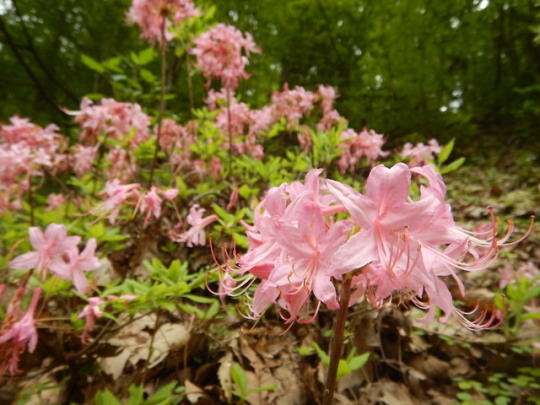


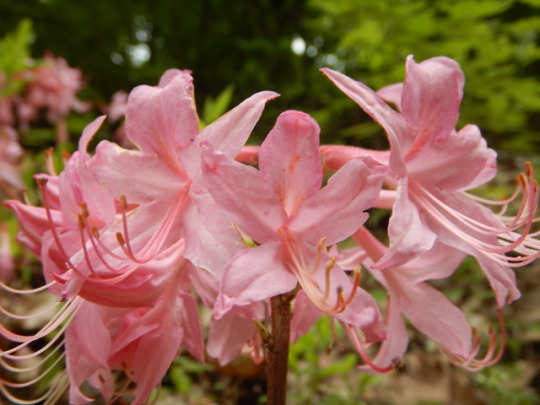
The Pinxter or Mountain Pink Azalea,
Rhododendron periclymenoides, is another classic species that is hard to pass up. The species follows many of the same trends that the Appalachian Flame Azalea is known for, from habitat to pollination. This species tends to have a much more closed off carolla tube than other species in my area and seems to garner more attention from the hummers than other species as well. We found this individual on a fairly steep road cut near the top of one of Ohio’s foot hills growing alongside an incredible seep based plant community. Interrupted ferns, whorled pogonia, shiney firm moss, Northern Maidenhair fern, and cinnamon fern, where just some species present in close proximity. Although it follows a highland trend overall, as long as the acidity is present and its protected from browsing it won’t be as fickle about where it lives.
16 notes
·
View notes
Text
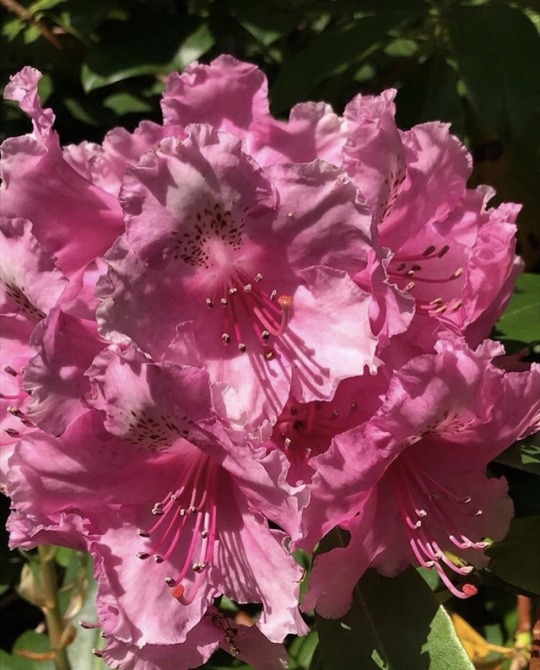
Pink azalea
—
Rhododendron periclymenoides
0 notes
Photo
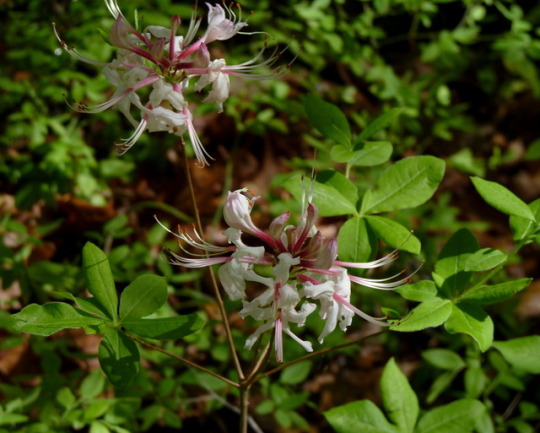
Pinxterbloom Azalea, Rhododendron periclymenoides (by me)
#Pinxterbloom Azalea#Rhododendron periclymenoides#Rhododendron#Ericoideae#Ericaceae#Ericales#flowers#shrub#plants#forest#spring#Cheesequake State Park#Middlesex County#New Jersey#mine
14 notes
·
View notes
Photo

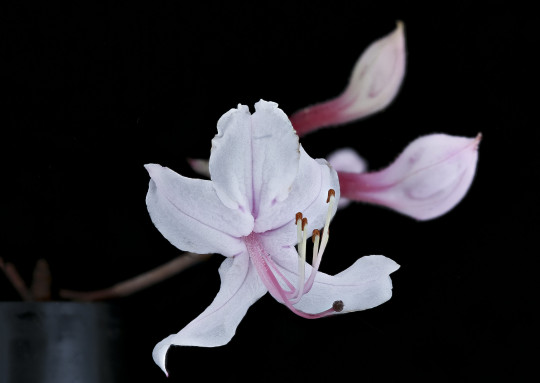
Here is one of the native azaleas...with the lovely name Pinxter (Rhododendron periclymenoides).
Note that most of the planted azaleas these days are not native and while they may or may not attract a few bumble bees and other species they are not nearly as excellent a species of plant to use as the Pinxter which has its own specialist bee, Andrena cornelli and is integrated into the surrounding natural world supporting many other insects and life forms that non-native azaleas do not, so, your choice, save the bees or not. Picture and specimen by Helen Lowe Metzman.
42 notes
·
View notes
Text

Wild azalea, Rhododendron periclymenoides
1 note
·
View note
Text
Call Out Post
This is a call out post for Rhododendron periclymenoides. It’s just a boring version of R. prinophyllum! How is a flower with no smell better than one that smells like cinnamon? It’s not!
Reblog to support scented flowers.
6 notes
·
View notes
Photo

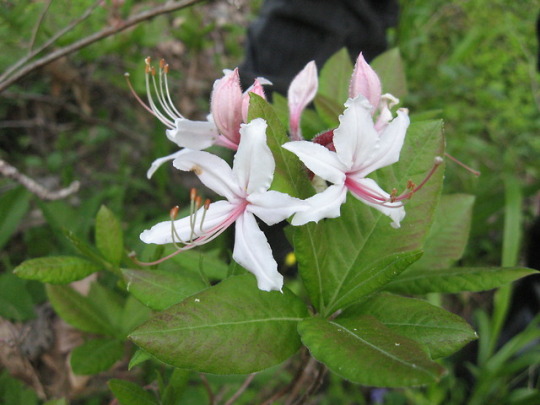
Pink azalea or pinxter flower (Rhododendron periclymenoides) is a species of shrub in the heath family. Like many members of the genus, the plant contains toxins in all parts of the flower.
33 notes
·
View notes
Text
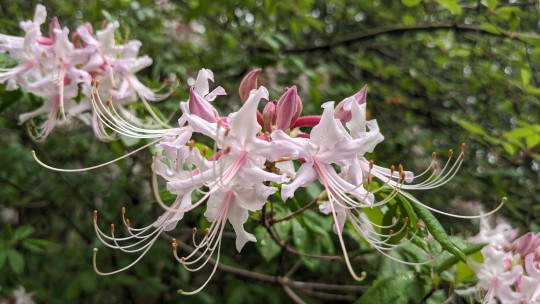
Rhododendron periclymenoides / Pinxter Flower at the Sarah P. Duke Gardens at Duke University in Durham, NC
#Rhododendron periclymenoides#Rhododendron#ericaceae#Pinxter Flower#Pink Azalea#Azalea#Azaleas#Native plants#Native flowers#Native shrubs#Plants#Flowers#Shrubs#Nature photography#photographers on tumblr#Sarah P. Duke Gardens#Duke Gardens#Duke University#Durham#Durham NC#North Carolina
1 note
·
View note
Photo
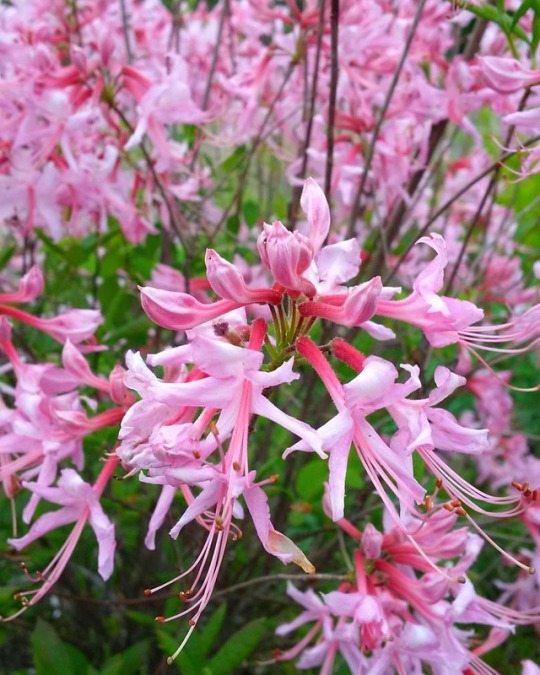
Wild Pink Azalea (Rhododendron periclymenoides) #Wild #Pink #Rhododendron #Azalea #Native #Connecticut #NewEngland #Wildflower #Nature #RhododendronPericlymenoides #Macro #Perspective #Life #Botany #Hiking #Trek #Bloom (at Columbia, Connecticut)
#rhododendronpericlymenoides#azalea#newengland#macro#nature#botany#perspective#wild#connecticut#wildflower#trek#native#life#rhododendron#hiking#bloom#pink
0 notes
Text
How to Grow & Care for Rhododendron Periclymenoides?

Did you know that the Pinxterbloom Azalea is a stunning native flowering shrub in eastern North America? With its late spring bloom time and fragrant pink flowers, this deciduous shrub is a favorite among gardeners and nature enthusiasts. Not only does it add beauty to gardens and landscapes, but it also attracts many plants such as bees and butterflies.
Pinxter Azalea (Rhododendron periclymenoides ) is a must-have deciduous shrub for any garden collection. Its delicate azaleas provide a burst of color and fragrance from their fragrant flowers that can't be missed. While there are various hybrids available, the pure beauty of this native species remains unmatched.
When caring for your Pinxterbloom Azalea plants, keep an eye out for leaf spot disease, which can affect the health of these shrubs. To ensure proper care, refer to label directions and consult a glossary of terms if needed. With their captivating appearance and ecological benefits, these azalea plants are sure to captivate both seasoned gardeners and beginners alike.
So why not bring some natural beauty into your backyard with the enchanting Pinxterbloom Azalea shrubs available at your local garden center? These stunning plants will add a pop of color to your garden.
Planting and Growing Rhododendron periclymenoides

To successfully grow and care for rhododendron periclenoides and other azaleas, there are a few important factors to consider. Follow these guidelines to ensure the optimal growth of these beautiful flowering shrubs. Visit your local garden center for the best selection of plants.
-
Choose a location with partial shade: Rhododendron periclymenoides thrives in partial shade, so select a spot in your garden that receives sunlight for only part of the day. This will provide the right balance for its growth.
-
Prepare the soil properly: Before planting, prepare the soil by adding organic matter like compost. This will improve drainage and enrich the soil with nutrients necessary for healthy growth.
-
Dig a hole twice as wide as the root ball: When planting your rhododendron periclymenoides, dig a hole that is twice as wide as the root ball. This will give its roots enough space to spread out and establish themselves.
-
Water regularly, especially during dry periods: Rhododendrons require consistent moisture, particularly during dry periods. Regular watering will help prevent wilting and promote healthy vegetative growth.
-
Be cautious about overwatering: While it's important to water regularly, avoid overwatering as it can lead to root rot and fungal growth. Ensure proper drainage in your planting area to prevent waterlogged conditions.
By following these simple steps, you can create an ideal environment for your azaleas to thrive. Remember to choose a suitable location with partial shade for your plants, prepare the soil properly, dig an appropriate hole when planting their leaves, and water regularly in the spring while avoiding overwatering.
To support the growth of your rhododendron periclymenoides during the spring season, you may also consider applying a suitable fertilizer specifically formulated for acid-loving plants. This will provide additional nutrients to promote healthy new growth and vibrant blooms, as the water and light from the sun are plentiful during this time.
Caring for Rhododendron periclymenoides
Aspect
Care for Rhododendron periclymenoides
Sun exposure
Partial shade to full shade
Soil
Well-draining, acidic soil
Watering
Regular watering, keeping the soil moist
Fertilization
Fertilize in spring with acid-loving fertilizer
Pruning
Prune after flowering to shape and remove dead wood
Mulching
Apply a layer of mulch to retain moisture and suppress weeds
Disease control
Monitor for diseases such as powdery mildew and treat them promptly
Pest control
Watch for pests like aphids and treat as needed
Winter care
Protect from harsh winter winds and frost with burlap or other coverings
Mulch around the base of the plants to conserve water and suppress weeds. This helps create a favorable environment for your rhododendron periclymenoides to thrive in the sun. Use organic mulch such as wood chips or pine needles, spreading it in a layer about 2-3 inches thick.
Cut back your plants after they have finished flowering to maintain their shape and remove any dead or damaged branches. This will not only improve the appearance of your plants but also encourage healthy growth. Use clean pruning shears to trim back any overgrown branches or those that are crossing each other. Ensure your plants receive plenty of light and sun for optimal growth.
Fertilize in early spring with a slow-release, acid-loving plant fertilizer to provide the necessary nutrients for rhododendrons. These plants prefer acidic soil, so it's important to choose a fertilizer specifically formulated for acid-loving plants. Follow the instructions on the packaging for proper application rates to ensure that your rhododendrons receive the right amount of water, sun, and light.
Monitor your plants for pests such as aphids or lace bugs and take appropriate action if necessary. These pests can cause damage to your rhododendron periclymenoides if left unchecked. If you notice signs of infestation, consider using organic insecticides or natural pest control methods recommended for rhododendrons. Additionally, ensure that you cut your plants regularly, provide them with enough water, and place them in a spot where they can get ample sun.
By following these care tips, you can ensure that your rhododendron periclymenoides plants remain healthy and vibrant throughout their growing season. Make sure to water your plants regularly and provide them with enough sun. Additionally, remember to cut off any dead or damaged parts of the plants to promote their overall health.
Understanding the Needs of Rhododendron periclymenoides

Rhododendron periclymenoides, commonly known as pinxterbloom azalea, is a beautiful flowering shrub that requires specific care to thrive in the sun and water. To ensure the health and vitality of this plant, it is essential to understand its need for sunlight and regular watering.
-
Well-Draining Soil: Rhododendron periclymenoides thrive in soil that drains well while retaining moisture. It is crucial to provide it with soil that is rich in organic matter, allowing for proper root development and nutrient absorption.
-
Acidic Soil pH: This species of rhododendron prefers acidic soil with a pH ranging from 4.5 to 6.0. Maintaining the appropriate pH level ensures optimal growth and nutrient availability for the plant.
-
Regular Watering: While rhododendron periclymenoides benefit from regular watering, it is important not to overwater it. The frequency of watering may vary depending on factors such as climate and soil moisture retention capacity. A good rule of thumb is to water when the top inch of soil feels dry.
-
Climate Considerations: This particular rhododendron variety performs best in regions with cool summers and mild winters. It appreciates a temperate climate where it can experience a dormant period during winter months without extreme cold temperatures.
By understanding the water and plants' needs, you can provide your rhododendron periclymenoides with an environment conducive to their growth and overall well-being.
Remember:
-
Use well-draining soil rich in organic matter.
-
Maintain an acidic soil pH between 4.5 and 6.0.
-
Water regularly but avoid overwatering.
-
Consider planting water-loving plants in regions with cool summers and mild winters.
With proper care, your rhododendron periclymenoides plants will flourish and reward you with stunning blooms. Water them regularly to ensure their growth and beauty.
Tips for Successful Rhododendron Periclymenoides Care
Tips for Successful Rhododendron Periclymenoides Care
1. Choose the right location for planting
2. Provide well-drained soil
3. Ensure proper watering
4. Mulch around the base of the plant
5. Prune after flowering
6. Protect from harsh winter conditions
7. Monitor for pests and diseases
8. Fertilize regularly
Protecting your rhododendron periclymenoides from strong winds is crucial to ensure the delicate blooms remain intact. Strong winds can easily damage these beautiful flowers, so it's important to provide them with a windbreak. Consider creating a windbreak using a fence or strategically planting taller shrubs around your rhododendron to shield the plants from the strong winds and prevent water loss.
When selecting a location for your rhododendron periclymenoides, avoid planting it near trees or shrubs that compete for water and nutrients. These plants can deprive your rhododendron of the essential water and nourishment it needs to thrive. Choose an area where it can receive ample sunlight and has access to well-draining soil that retains water.
To promote healthy growth, make use of an ericaceous fertilizer specifically formulated for rhododendrons. These acid-loving plants require specific nutrients, including water, that are not always present in regular fertilizers. Look for a fertilizer designed specifically for rhododendrons and follow the instructions on the packaging for the best results.
Regularly monitoring soil moisture levels is vital to keep your rhododendron periclymenoides, a type of plant, happy and healthy. Use your finger or a moisture meter to check the moisture content in the soil. Aim to keep the soil consistently moist but not waterlogged. Overwatering can lead to root rot, while underwatering can cause stress and hinder the growth of plants.
By following these tips, you'll successfully grow and care for your rhododendron periclymenoides plants. Protect them from strong winds, choose their planting location wisely, use specialized fertilizer, and diligently monitor soil moisture levels. With proper care, you'll enjoy vibrant blooms and lush foliage from these stunning water-loving plants.
Ideal Conditions for Rhododendron Periclymenoides Growth
Ideal Conditions for Rhododendron Periclymenoides Growth
Temperature
Light
Soil
Moisture
pH level
Fertilizer
Pruning
To ensure optimal growth and care for your rhododendron periclymenoides, it is essential to create ideal conditions for plants. Here are some key factors to consider, such as providing adequate water for your plants.
-
Location: Choose a spot that provides dappled sunlight or morning sun with afternoon shade. This will protect the plant from scorching and help it thrive.
-
Soil Drainage: Ensure the soil has good drainage to prevent root rot. Rhododendrons prefer well-draining soil, so avoid waterlogged areas.
-
Moisture Levels: Maintain consistent moisture levels in the soil without overwatering. Rhododendrons require enough water to stay hydrated but can suffer if their roots are constantly soaked.
-
Winter Protection: Shield your rhododendron from extreme temperatures, especially during winter. Harsh cold can damage the plant, so consider covering it or moving it to a sheltered location when necessary.
By considering factors such as hardiness zone, soil moisture, and pH levels, you can create suitable conditions for your rhododendron periclymenoides to flourish. Remember to provide the right environment for your plants by taking into account water and other essential factors.
Now that you know how to create ideal conditions for your rhododendron periclymenoides, including proper watering, you're one step closer to enjoying its vibrant blooms and lush foliage.
Troubleshooting Common Issues with Rhododendron periclymenoides
Common Issues
Causes
Solutions
Pest infestation
Insects such as aphids, scale insects, and spider mites
Use insecticidal soap or neem oil to control pests
Fungal diseases
Overwatering, poor drainage, or humid conditions
Improve drainage, water in the morning, and apply fungicides
Nutrient deficiencies
Lack of essential nutrients such as nitrogen, phosphorus, or iron
Apply appropriate fertilizers or amendments to correct deficiencies
Leaf discoloration
Sunburn, nutrient deficiencies, or pH imbalance
Provide shade, adjust soil pH, or address nutrient deficiencies
Wilting or drooping leaves
Underwatering, overwatering, or root rot
Adjust watering schedule, improve drainage, or treat root rot if present
Poor flowering
Lack of sunlight, improper pruning, or nutrient deficiencies
Provide adequate sunlight, prune properly, and fertilize as needed
Stunted growth
Lack of sunlight, poor soil quality, or overcrowding
Ensure proper sunlight, improve soil quality, and space plants adequately
Winter damage
Cold temperatures, frost, or windburn
Provide winter protection such as mulching or covering with burlap
Transplant shock
Damage to roots during transplanting
Minimize root disturbance, water thoroughly after transplanting, and provide shade
Leaf spot
Fungal or bacterial infections
Remove affected leaves, improve air circulation, and apply appropriate fungicides or bactericides
Yellowing leaves
-
Nutrient deficiencies or overwatering can cause yellowing leaves.
Brown spots on leaves
-
Fungal diseases like leaf spots may be the culprit behind brown spots on plants' leaves due to lack of water.
Wilting or drooping foliage
-
Underwatering or root issues can lead to wilting or drooping foliage in plants.
Stunted growth or lack of blooms
-
Improper pruning or insufficient light can result in stunted growth or a lack of blooms in plants. Water is also crucial for their healthy development.
If you notice any problems with your rhododendron periclymenoides plants, it's important to take action. Address nutrient deficiencies by fertilizing appropriately and ensuring proper watering practices for your plants. If fungal diseases are present, consider using fungicides recommended for leaf spot treatment on your plants.
To prevent wilting, make sure your plants are receiving adequate water and check for any root problems that may need attention. For stunted growth or a lack of blooms, evaluate your pruning techniques and provide sufficient light exposure for your plants.
Remember that crown rot is another potential issue to watch out for in rhododendron periclymenoides. This condition occurs when the base of the plant becomes infected and starts to decay. To prevent crown rot, avoid overwatering, and improve drainage around the roots by adding organic matter to the soil. Regularly inspect your plants for any signs of crown rot and promptly remove affected areas if detected.
By troubleshooting common issues promptly and providing appropriate care, you can ensure your plants, such as the rhododendron periclymenoides, thrive and produce beautiful blooms year after year. This includes giving them the necessary water they need to flourish.
Enjoying the Beauty of Rhododendron periclymenoides

Congratulations on taking the first steps towards growing and caring for Rhododendron periclymenoides! With proper attention and care, you can enjoy the vibrant beauty of these stunning plants in your garden. Let's summarize what we've covered so far: watering is essential for the growth and health of your Rhododendron periclymenoides.
-
Planting and Growing Rhododendron Periclymenoides: We discussed the importance of choosing a suitable location for planting these plants, preparing the soil to ensure their optimal growth, and providing them with adequate sunlight and water.
-
Caring for Rhododendron periclymenoides: We explored essential maintenance tasks such as watering, pruning, fertilizing, and protecting against pests and diseases to ensure the health and longevity of your plants.
-
Understanding the Needs of Rhododendron periclymenoides: By learning about the specific requirements of these plants for soil acidity, moisture levels, and temperature tolerance, you can create an environment that fosters their growth and ensures they receive adequate water.
-
Tips for Successful Rhododendron Periclymenoides Care: We provided valuable tips on mulching, winter protection, regular monitoring, and watering to address potential issues before they become major problems.
-
Ideal Conditions for Rhododendron Periclymenoides Growth: By replicating their natural habitat conditions such as partial shade, well-drained soil, and adequate water, you can optimize the growth potential of these plants.
-
Troubleshooting Common Issues with Rhododendron Periclymenoides: We highlighted common problems like leaf discoloration or wilting in these plants and offered solutions to overcome water-related issues effectively.
Now that you have a solid understanding of how to grow and care for rhododendron periclymenoides, it's time to put your knowledge into action! Get started by selecting healthy plants from reputable nurseries or propagating them from cuttings. Remember, patience and consistent care are key to enjoying the full beauty of these remarkable water-loving plants.
FAQs
How often should I water my rhododendron periclymenoides?
The Rhododendron periclymenoides plant thrives in moist soil, making regular watering crucial.
Read the full article
0 notes
Photo

Rhododendron periclymenoides (pinxterflower) #cokerarboretum #ncbg #northcarolinabotanicalgarden #unc #chapelhill #springflowers #shrubs #rhododendron #rhododendronpericlymenoides #pinxterflower #native #nativeplants #nativeflora #gffry (at Coker Arboretum)
#northcarolinabotanicalgarden#chapelhill#shrubs#rhododendronpericlymenoides#cokerarboretum#nativeplants#native#unc#springflowers#pinxterflower#rhododendron#ncbg#gffry#nativeflora
0 notes
